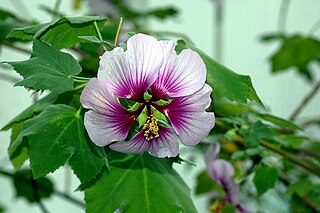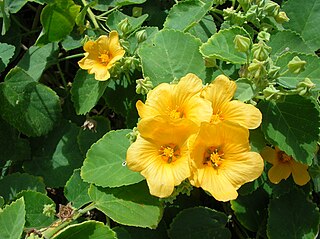
The Malvales are an order of flowering plants. As circumscribed by APG II-system, the order includes about 6000 species within 9 families. The order is placed in the eurosids II, which are part of the eudicots.

Malvaceae, or the mallows, is a family of flowering plants estimated to contain 244 genera with 4225 known species. Well-known members of economic importance include okra, cotton, cacao and durian. There are also some genera containing familiar ornamentals, such as Alcea (hollyhock), Malva (mallow) and Lavatera, as well as Tilia. The largest genera in terms of number of species include Hibiscus, Sterculia, Dombeya, Pavonia and Sida.

Bombacaceae were long recognised as a family of flowering plants or Angiospermae. The family name was based on the type genus Bombax. As is true for many botanical names, circumscription and status of the taxon has varied with taxonomic point of view, and currently the preference is to transfer most of the erstwhile family Bombacaceae to the subfamily Bombacoideae within the family Malvaceae in the order Malvales. The rest of the family were transferred to other taxa, notably the new family Durionaceae. Irrespective of current taxonomic status, many of the species originally included in the Bombacaceae are of considerable ecological, historical, horticultural, and economic importance, such as balsa, kapok, baobab and durian.

Malva is a genus of about 25–30 species of herbaceous annual, biennial, and perennial plants in the family Malvaceae, one of several closely related genera in the family to bear the common English name mallow. The genus is widespread throughout the temperate, subtropical and tropical regions of Africa, Asia and Europe.

Corchorus is a genus of about 40–100 species of flowering plants in the family Malvaceae, native to tropical and subtropical regions throughout the world.
Tiliaceae is a botanical name for a family of flowering plants. It is not a part of the APG, APG II and APG III classifications, being sunk in Malvaceae as a modified Tilioideae but has an extensive historical record of use.

Lavatera is a genus of about 25 species of flowering plants in the mallow family Malvaceae, native to Macaronesia, North Africa, Europe, central and southwestern Asia, Ethiopia, North America and Australia, with a centre of distribution in the Mediterranean region. A number of species are naturalized in North America and elsewhere.

Abroma is a genus in the family Malvaceae, with one or two species from Asia and Australia. Ambroma is an orthographic variant.

Sida is a genus of flowering plants in the mallow family, Malvaceae. They are distributed in tropical and subtropical regions worldwide, especially in the Americas. Plants of the genus may be known generally as fanpetals or sidas.

Malvoideae is a botanical name at the rank of subfamily, which includes in the minimum the genus Malva. It was first used by Burnett in 1835, but was not much used until recently, where, within the framework of the APG System, which unites the families Malvaceae, Bombacaceae, Sterculiaceae and Tiliaceae of the Cronquist system, the aggregate family Malvaceae is divided into 9 subfamilies, including Malvoideae. The Malvoideae of Kubitzki and Bayer includes 4 tribes:-

Pavonia is a genus of flowering plants in the mallow family, Malvaceae. The generic name honours Spanish botanist José Antonio Pavón Jiménez (1754–1844), as chosen by his contemporary, Spanish botanist Antonio José Cavanilles. Several species are known as swampmallows.

Lagunaria is a monotypic genus in the family Malvaceae. It is an Australian plant which is native to Lord Howe Island, Norfolk Island and parts of coastal Queensland. It has been introduced to many parts of the world. The genus was named for its resemblance to the earlier genus Laguna Cav., which was named in honour of Andrés Laguna, a Spanish botanist and a physician to Pope Julius III.

Eriolaena is a genus of flowering plants. Traditionally included in the family Sterculiaceae, it is included now in the recently expanded Malvaceae. The genus is distributed in Asia.
Julostylis polyandra is a species of flowering plant in the family Malvaceae. It is found only in India.

Lebronnecia is a monotypic genus of flowering plants in the family Malvaceae. The sole species is Lebronnecia kokioides, a very rare flowering shrub.

Lasiopetalum, commonly known as velvet bushes, is a genus of about forty-five species of flowering plants in the family Malvaceae, all endemic to Australia.

Sterculioideae is a subfamily of the family Malvaceae containing evergreen and deciduous trees and shrubs.

Hibisceae is a tribe of flowering plants in the mallow family Malvaceae, subfamily Malvoideae.

Megistostegium is a genus of trees and shrubs in the family Malvaceae. The species are all endemic to Madagascar. The genus is threatened by livestock grazing, invasive plants and threats to pollinators.

Plagianthus is a genus of flowering plants confined to New Zealand and the Chatham Islands. The familial placement of the genus was controversial for many years, but modern genetic studies show it definitely belongs in the Malvaceae subfamily Malvoideae. The name means "slanted flowers".

















